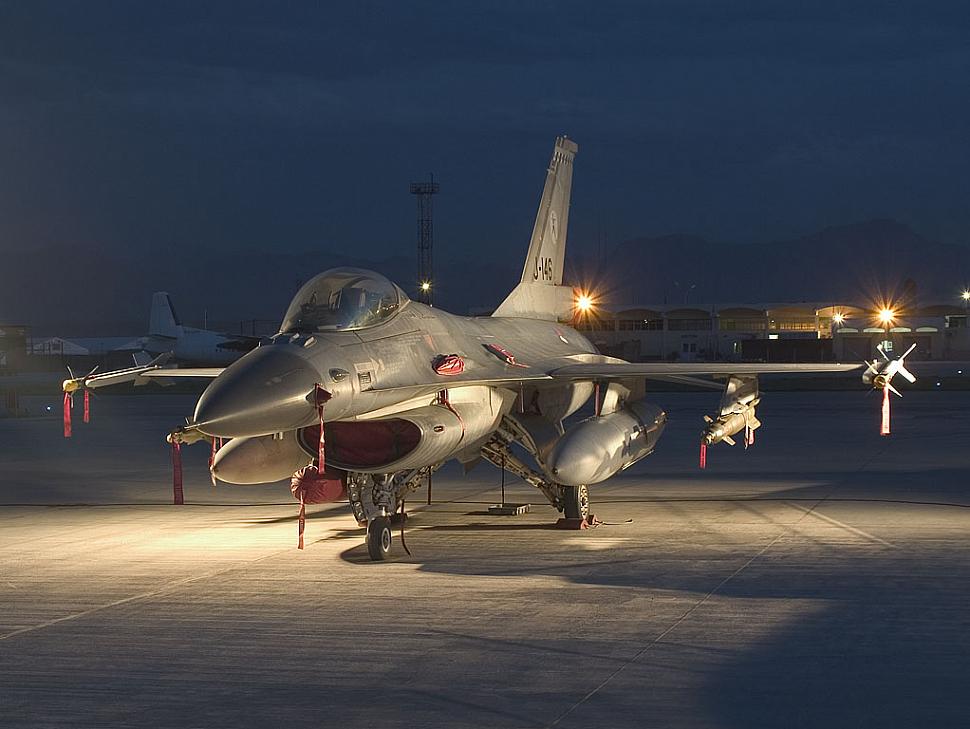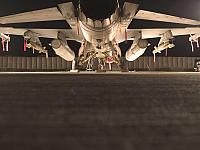Fighter Jet News
F-16 Fighting Falcon News
F-16 mishap horror
July 12, 2007 (by
Joris Janssen Lok) -
Did the pilot of a RNlAF F-16 that went down over Afghanistan last year encounter a creepy crawly creature in his cockpit? This might seem the only sensible explanation...

A sting by a camel spider, a scorpion or even a cobra appears to be the only remotely possible explanation why the jet suddenly departed from its cruising altitude and crashed into terrain August 31, 2006.
That is the conclusion of the official investigation into the accident, the results of which were published yesterday by the Netherlands defense ministry in The Hague.
The Royal Netherlands Air Force F-16 (J-364) had taken off from Kabul International Airport, Afghanistan, as the leader of a formation of two. After join-up and climbout, the two jets, each armed with a LANTIRN targeting pod and two GBU-12 laser-guided bombs, headed southwest toward their intended mission area, cruising at Flight Level 320 (32,000 ft above sea level) and a relatively slow speed of 280 kts.
About four minutes after crossing the path of a commercial airliner (that was flying 1,000 ft higher than the two fighters) the pilot of the lead F-16, Captain Michael Donkervoort, suddenly made a mayday call.
His wingman, flying approximately 2 nmi away in line-abreast formation, saw Donkervoort's F-16 pitch down while starting a continuous right roll. Without any further communication from its pilot, the jet impacted the 10,000-ft high mountains 30 seconds later, in a near vertical attitude (80 degrees nose down and 120 degrees right bank) at very high speed (approximately Mach 1.2). Capt. Donkervoort was killed instantly.
Based on the circumstances, the (very few) pieces of wreckage that could be recovered, and extensive simulation runs performed in cooperation with Lockheed Martin, the investigation committee has concluded that it is impossible to point out for sure what caused the crash.
The committee investigated a wide range of possible (contributing) causes of technical, physical, psychological and procedural nature.
One of the more trivial possible causes that was studied involved the pilot inadvertently causing a dive and roll during the urinating procedure. That typically involves removing the lap belt and moving the ejection seat into the highest position.
In one U.S. Air Force F-16 mishap, an aircraft was lost because the buckle of the lap belt got jammed between the right side of the seat and the control stick when the seat was moved upwards (in that case, the pilot managed to eject safely after failing to regain control of the jet).
But the Dutch committee concluded there was no evidence whatsoever to suggest that had happened to Capt. Donkervoort.
The only possible cause that "is unlikely but that cannot be excluded" is the presence of an insect, arachnid or other animal in the cockpit.
According to the report, a camel spider has been found in the cockpit of an F-16 at least once during the deployment of the Dutch F-16s in Kabul. In that case the arachnid was spotted when the aircraft was parked on the flightline. The F-16 was grounded for a day before the cockpit could be declared free of bugs.
Other possible animals that could have entered the cockpit while the F-16 was parked on the flightline at Kabul include a snake (cobra or adder), a scorpion, or a wasp, the report says.
None of these have the capability to incapacitate a human being within seconds. However, the discovery of a camel spider (a large species with a bizarre look and phenomenal speed of movement) or a snake could certainly have triggered the pilot's mayday call and then have distracted him to the extent that he was not able to notice and/or influence the attitude of his aircraft.
In a letter accompanying the report, Dutch defense minister Eimert van Middelkoop announced he has ordered a standing procedure to thoroughly check the cockpit of each aircraft before flight specifically for the presence of insects, arachnids or other animals, if the canopy has been open for an extended period of time.
Other recommendations include the development of a standard procedure for urinating in flight (to prevent possible flight control blockages as described above), as well as painting ejection seat data recorders in bright colors (to make them easier to find after a crash. In this case, the recorder is still missing, probably because of the destructive forces of the high-speed impact).

RnLAF F-16 on the flightline at Kabul International Airport. Did a camel spider manage to get inside the cockpit?
That is the conclusion of the official investigation into the accident, the results of which were published yesterday by the Netherlands defense ministry in The Hague.
The Royal Netherlands Air Force F-16 (J-364) had taken off from Kabul International Airport, Afghanistan, as the leader of a formation of two. After join-up and climbout, the two jets, each armed with a LANTIRN targeting pod and two GBU-12 laser-guided bombs, headed southwest toward their intended mission area, cruising at Flight Level 320 (32,000 ft above sea level) and a relatively slow speed of 280 kts.
About four minutes after crossing the path of a commercial airliner (that was flying 1,000 ft higher than the two fighters) the pilot of the lead F-16, Captain Michael Donkervoort, suddenly made a mayday call.
His wingman, flying approximately 2 nmi away in line-abreast formation, saw Donkervoort's F-16 pitch down while starting a continuous right roll. Without any further communication from its pilot, the jet impacted the 10,000-ft high mountains 30 seconds later, in a near vertical attitude (80 degrees nose down and 120 degrees right bank) at very high speed (approximately Mach 1.2). Capt. Donkervoort was killed instantly.
Based on the circumstances, the (very few) pieces of wreckage that could be recovered, and extensive simulation runs performed in cooperation with Lockheed Martin, the investigation committee has concluded that it is impossible to point out for sure what caused the crash.
The committee investigated a wide range of possible (contributing) causes of technical, physical, psychological and procedural nature.
One of the more trivial possible causes that was studied involved the pilot inadvertently causing a dive and roll during the urinating procedure. That typically involves removing the lap belt and moving the ejection seat into the highest position.
In one U.S. Air Force F-16 mishap, an aircraft was lost because the buckle of the lap belt got jammed between the right side of the seat and the control stick when the seat was moved upwards (in that case, the pilot managed to eject safely after failing to regain control of the jet).
But the Dutch committee concluded there was no evidence whatsoever to suggest that had happened to Capt. Donkervoort.
The only possible cause that "is unlikely but that cannot be excluded" is the presence of an insect, arachnid or other animal in the cockpit.
According to the report, a camel spider has been found in the cockpit of an F-16 at least once during the deployment of the Dutch F-16s in Kabul. In that case the arachnid was spotted when the aircraft was parked on the flightline. The F-16 was grounded for a day before the cockpit could be declared free of bugs.
Other possible animals that could have entered the cockpit while the F-16 was parked on the flightline at Kabul include a snake (cobra or adder), a scorpion, or a wasp, the report says.
None of these have the capability to incapacitate a human being within seconds. However, the discovery of a camel spider (a large species with a bizarre look and phenomenal speed of movement) or a snake could certainly have triggered the pilot's mayday call and then have distracted him to the extent that he was not able to notice and/or influence the attitude of his aircraft.
In a letter accompanying the report, Dutch defense minister Eimert van Middelkoop announced he has ordered a standing procedure to thoroughly check the cockpit of each aircraft before flight specifically for the presence of insects, arachnids or other animals, if the canopy has been open for an extended period of time.
Other recommendations include the development of a standard procedure for urinating in flight (to prevent possible flight control blockages as described above), as well as painting ejection seat data recorders in bright colors (to make them easier to find after a crash. In this case, the recorder is still missing, probably because of the destructive forces of the high-speed impact).
Published on July 11, 2007 in the Aviation Week Defense Technology Blog.
Republished with kind permission of Joris Janssen Lok
Aviation Week Copyright 2007, The McGraw-Hill Companies, Inc
In Memoriam
Additional images:
Related articles:
Forum discussion:
Tags
Forum discussion:
- Dutch F-16 went down in Afghanistan - Aug 2006 ( 21 replies)
Tags

